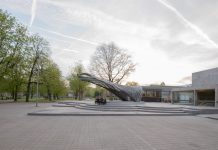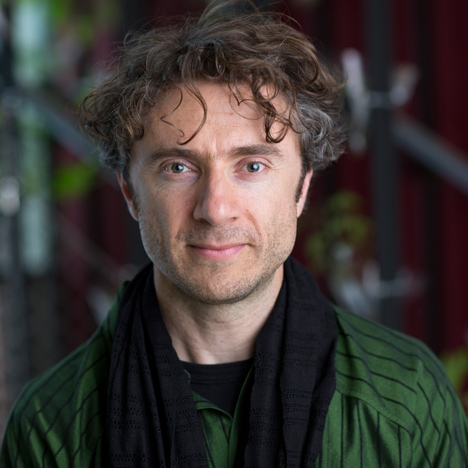
Speaking at the launch of his first major built project in the UK – a gin distillery in Hampshire – London designer Thomas Heatherwick said he was “lucky” to be a British designer, but said projects that promoted industry in the UK were “rare” (+ interview).
Opening this week, the Bombay Sapphire Distillery at Laverstock Mill in Hampshire is Heatherwick’s biggest built project in his home country, despite having created some of the most iconic British designs in recent years including the London 2012 Olympic Cauldron and the UK’s pavilion at the Shanghai Expo in 2010.
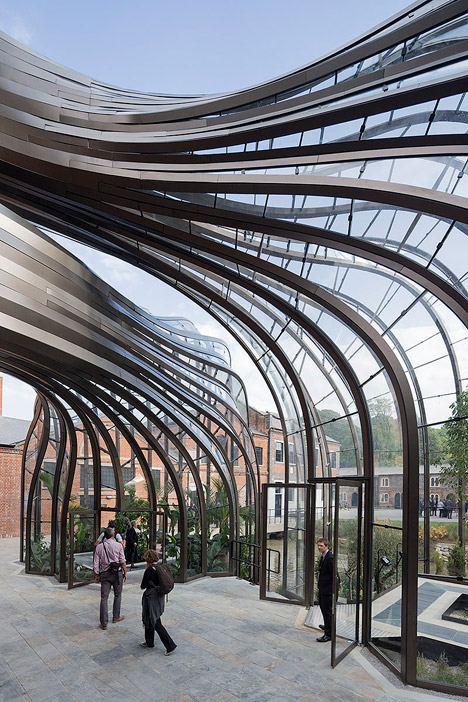 Photograph by Iwan Baan
Photograph by Iwan Baan
Heatherwick said that British designers were enjoying a period of “receptiveness” in the industry.
“Some of the best minds of the world are based in Britain and I feel very lucky to be working at a time when there is receptiveness to what we’re all doing,” said Heatherwick.
Related story: Thomas Heatherwick’s gin distillery for Bombay Sapphire opens
“When we worked on the UK pavilion in Shanghai I was trying to redress the image of Britain only being about castles and Sherlock Holmes and postboxes, to the level of innovation and different lateral thinking that in Britain we have around us. I feel lucky to be working at this time and in that context.”
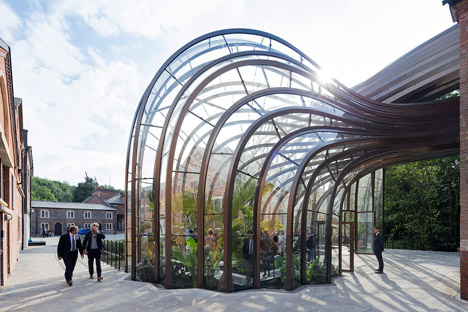 Photograph by Iwan Baan
Photograph by Iwan Baan
Heatherwick said the distillery project, which involved reviving an historic paper mill, was an opportunity to celebrate British industry and production – which has been in decline after years of political neglect and recession.
“This could easily become a gated housing community, but it’s most meaningful if we can retain in-Britain production,” he said. “What drove our excitement in this project, the whole way through, was how rare that was to grow production in Britain.”
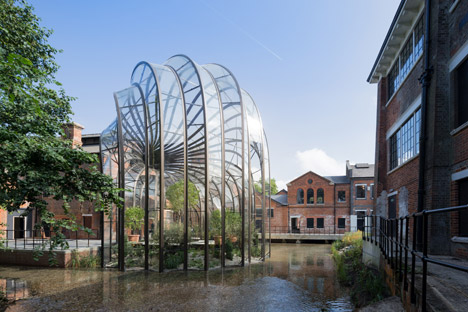 Photograph by Iwan Baan
Photograph by Iwan Baan
Laverstoke Mill operated as a paper mill and sole-manufacturer of Bank of England bank notes between 1719-1963, but the site sat unused for over a decade before singled out as the new home for Bombay Sapphire Distillery.
Heatherwick Studio began work on the Bombay Sapphire Distillery four years ago, at the height of the recession when many industries were making cutbacks.
21 lean-to extensions and structures were removed from the “jumble” of 49 existing buildings on the site, leaving a collection of low-rise red brick buildings that date from the mid-19th to 20th centuries, three of which are now Grade-II listed.
“We felt blessed to have a site with so many layers to work with, and a sense that we were just adding a next layer, an imprint,” said Heatherwick. “In another two centuries from now, will this still be a distillery or will it be reappropriated for another form of manufacture? Whatever we do, if we can make it that housing is the least likely to be, that would be great.”
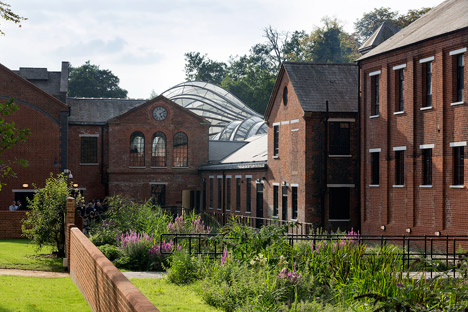 Photograph by Iwan Baan
Photograph by Iwan Baan
The River Test, which once powered the mill, had been “industrially squashed”, and was excavated as part of the project to increase its breadth by up to three times at its widest. The main distillery entrance to the distillery is positioned over this newly exposed section of river.
It runs from the entrance park, below the main entrance hall of the building and pools under the centrepiece of Heatherwick’s design – a pair of glasshouses that contain the 10 botanicals used to create the London gin’s distinctive flavor.
These fluted glass structures are made up of over 10, 000 separate components and represent a reaction against the “sterility” of modern high-tech glasshouse design, according to Heatherwick.
“There’s been this heritage of historical phenomenal glasshouses, people like Joseph Paxton, who did the palm house at Kew, and The Crystal Palace,” he said.
“We felt that there was an opportunity to make the smallest attempt to regain some of the confidence that some of those glasshouses and structures used to have. In high-tech manufacture, sterility has crept into more recent forms of glasshouses.”
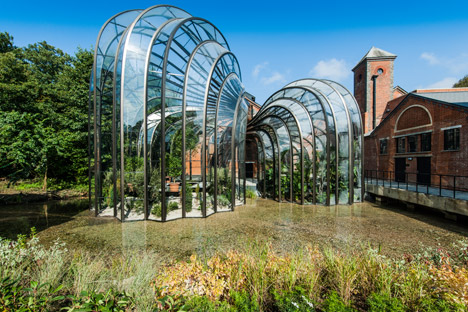
The taller of the two structures stands at 15-metres-high and houses botanicals originating in a Mediterranean climate, the shorter 11-metre-high structure is kept at 75 per cent humidity to suit tropical species. A flue at the top of each hothouse connects with the redbrick building to the rear, which houses two copper gin stills and an educational area for visitors.
The heat produced by the stills is drawn into air vents below grates in both glasshouses and not only heats the houses but encourages air circulation that prevents a build up of condensation on the panes.
Together the structures form an educational area for visitors that is integrated into the main body of the distillery, and Heatherwick’s get-out clause for the visitor centre that was originally included in the brief. “We actually felt allergic to visitor centres,” said Heatherwick.
Read on for an edited transcript of the interview with Thomas Heatherwick and project architect Eliot Postma:
Jessica Mairs: Can you tell me about how you came to work on the distillery project?
Thomas Heatherwick: The studio was lucky to win a competition. Bombay Sapphire had a glass design prize every year for about a decade, and we won it about ten years ago. It was a design for a glass bridge – an idea for a concept of a bridge built from just glass. Ten years later we won a competition, to figure out how we could turn this historical, complex jumble of buildings, untangle it and put industrial production into it.
 Site plan –
Site plan –
Jessica Mairs: Can you tell me about the changes you’ve made to the site?
Eliot Postma: Really the predominant thing, and what we felt when Thomas and myself first visited the site, was that there was this amazing asset sitting right in the heart of it. It’s the clearest river – it’s certainly the most beautiful river – that I’ve seen in the UK and you just couldn’t see it. We came here and we walked around and it was a couple of old buildings and there was just this general sense of a maze on the site and you would feel lost as you were walking around it.
So it was two things – an amazing opportunity to bring this river back to life, whilst [allowing] the historic buildi
ngs on site to sort of breathe. These modern buildings had started to suffocate it a little bit. The real focus for us was creating this organisational device, using the river to help people understand the way through the site and navigate their way across it. So, widening those riverbanks and bringing their natural habitat back.
Thomas Heatherwick: Because it [the river] had been channeled. There was no foreshore. So there was no sort of interstitial space between English countryside and the other piece of the countryside, which was the river water itself – the purest in Britain. All channeled, industrially squashed. By opening it up we not only allowed you to see it, but we also allowed the plants and animal species to thrive and reconnect itself, in certain places opening it up to three times as wide as it originally had been which was exciting to be able to do.
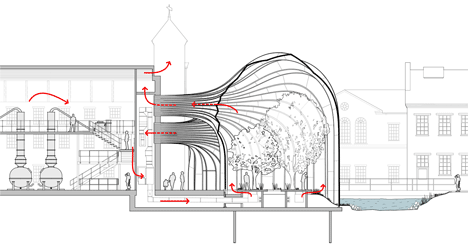 Glasshouse section –
Glasshouse section –
The trigger of it was this making of a public space at the heart of the site, using the decision to put the arrival over to one part so that the river drew through the site and that heart space wasn’t immediately as you arrived. I suppose we deliberately used our master plan to tease you, you can see some clues over the top from where you first arrive. The river draws you towards them, and then pulls you in. There were 21 different structures needing to be removed to do that. So that was a big work.
I was brought up with the sense that English Heritage stopped everything, but actually English Heritage were fantastic and really worked with us and get the spirit of what we were trying to do. This could easily become a gated housing community, but it’s most meaningful if we can retain in Britain production. So what drove our excitement in this project, the whole way through, was how rare that was to grow production in Britain.
We were able to use the excess heat from the production to grow the plants that are key to the particularity of that product and then place them in the river itself. And the Environment Agency and British Nature really worked with us to let that happen. I don’t think we expected that.
So in a way it’s a big sign of a culture in these British agencies of openness. People sometimes assume that they’re going to be limited.
Jessica Mairs: Other than the glasshouses, have you added any new structures to the site?
Eliot Postma: For this to be a state-of-the-art distillery there are certain production facilities that needed to come in. A huge aspect of the master plan was ensuring that tankers could come in and there’s also an enormous sprinkler tank behind these buildings here, so there are other aspects that we’ve had to add in that were production orientated to make the distillery work and make it as efficient as possible.
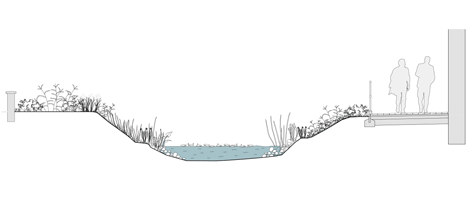 River section
River section
Jessica Mairs: Can you tell me about the glasshouses?
Thomas Heatherwick: The shape is derived from this need, by creating an umbilical link, to use the excess heat from the gin production we needed to collect, in order to be able to take the warm air in at the low level and then extract the air from the top to make it flow. So that was driven by the physics of the air movement.
There’s been this heritage of historical phenomenal glasshouses, people like Joseph Paxton, who did the palm house at Kew, and The Crystal Palace. We felt that there was an opportunity to make the smallest attempt to regain some of the confidence that some of those glasshouses and structures used to have. In high-tech manufacture, sterility has crept into more recent forms of glasshouses.
We looked at some of the cloches that were used in some of the kitchen gardens. Gardeners used these glass domes that they placed over particular plant specimens that they want to give extra heat to and to help them grow. So to us these were just like two cloches. The Victorians also had a craze for these things called wardian cases which people would have in their living rooms and grow exotic plant species in. We were really interested in these wardian cases and the culture for the glasshouses with botanical specimens in. [We thought] why can’t this be a botanical distillery. So that drove a lot of our decisions.
 River section
River section
80 per cent of our work was with the exiting buildings and only 20 per cent with the glass houses. With the existing buildings, in general they were office buildings with polystyrene ceilings and nasty fitted carpets and so there were no spaces big enough to have the stills. So it was figuring out how we could create gin halls of sufficient space, working to see whether we could get permission for those major moves – three of those buildings were grade II listed structures. And then trying to unreel – sort of delicately take off layers – and be proud of all the layers and layers that exist here because the site is built up from the mill workers cottages, which are built up literally over centuries.
We felt blessed to have a site with so many layers to work with and a sense that we were just adding a next layer and imprint. In another two centuries from now, will this still be a distillery or will it be reappropriated for another form of manufacture? Whatever we do, if we can make it that housing is the least likely to be, that would be great.
Jessica Mairs: This is your first major project in the UK. How do feel about the state of British design and where you fit into that?
Thomas Heatherwick: I think some of the best minds of the worlds are based in Britain and I feel very lucky to be working at a time when there is receptiveness to what we’re all doing. When we worked on the UK pavilion in Shanghai, I was trying to redress the image of Britain only being about castles and Sherlock Holmes and postboxes, to the level of innovation and different lateral thinking that in Britain we have around us. I feel lucky to be working at this time and in that context.



